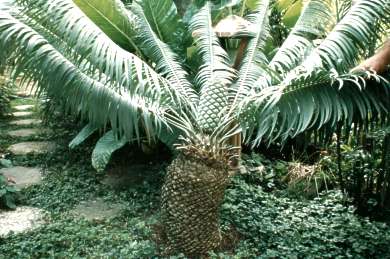Encephalartos inopinus
Encephalartos inopinus R.A.Dyer
Family: Zamiaceae
Common names: Lydenburg cycad
SA Tree No: 5.1
Introduction
This unusual, attractive African cycad (comparable to the Mexican companion Dioon or a Cuban Microcycas) tolerates both sun and frost, making it a very desirable garden plant. It is threatened in the wild, so please be sure to obtain plants from cultivated stock and reputable suppliers if you wish to grow it.

Description
Description

Plants are single or multistemmed (3-8 stems) and grow up to 2 m in height, sometimes up to 4 m in length for those with a procumbent (lying on the ground without rooting) growth habit. Plants have a distinctive bluish green foliage, covered with a silver powdery bloom. Male plants can produce up to five cones per crown, whereas the female plants produce between 1 and 3 cones per crown. Female cones are bluish green when young, becoming greenish yellow when mature; male cones remain a bluish colour, similar to the leaves, even at maturity. Plants sucker freely.
Distribution and habitat
Distribution description
Lydenburg cycads are naturally restricted to Mpumalanga in South Africa and grow in sparse to thick deciduous bush, within deep gorges, among the dolomite rock. Plants are found in the valleys of the Olifants and Steelpoort Rivers. Plants grow well in semi-shade and full sun and are relatively frost hardy.
Derivation of name and historical aspects
History
Encephalartos inopinus was originally discovered in 1955 in Lydenburg, South Africa where a sucker was obtained from the mother plant, and then taken to Johannesburg for cultivation. In 1964, after the second collection was made, Dr R.A. Dyer, a former director of the Botanical Research Institute, described this magnificent and remarkable cycad species.
The word Encephalartos comes from the Greek words en = in, cephale = a head, and artos = bread, and refer to the starchy material in the trunks of some species which is used for food. The Latin word inopinus means unexpected, a reference to the type locality, Onverwacht Farm (Dutch = unexpected), and to the fact that the discovery of a cycad species at that time, was unexpected among the South African botanical fraternity.
Ecology
Ecology
The caterpillar of the leopard magpie moth (Zeronopsis leopardina), feed on newly formed leaves from the suckers of E. inopinus, resulting in stunted growth. Baboons are reported to destroy the immature female cones of Lydenburg cycads, thus jeopardizing any chance of seed formation in their natural habitat. This and unscrupulous collecting have resulted in this plant being very endangered in the wild. Cultivation is recommended as an alternative to ensure their survival.
Growing Encephalartos inopinus
Grow

Plants are well suited to temperate and subtropical climates. They make good garden subjects on their own or can be mixed with aloes, euphorbias and any other succulent plants to create a water-wise garden in full sun. Furthermore, they are fascinating if grown together with palms and herbaceous perennials where a tropical effect is desired. They are ideal pot plants, and remain admirable for their entire growing period.
Propagation of E. inopinus is easy from seeds or suckers. For more details about growing cycads from seed see Encepharlatos ferox.
Lydenburg cycads require a minimal amount of water and unfortunately are more vulnerable to rot infection than most other cycad species. The rainfall in their natural environment is about 375 mm per year, mainly in summer. Improve soil drainage or grow these cycads on a slope, as they are often found in nature, to prevent rot.
References
- Giddy, C. 1974. Cycads of South Africa. Purnell, Cape Town.
- Goode, D. 2001. Cycads of Africa, vol. 1. D&E Cycads of Africa,. GalloManor
- Grobbelaar, N. 2002. Cycads. Published by the author, Pretoria.
- Krempin, J. 1990. Palms and cycads around the world. Horwitz Grahame, Australia.
- Osborne, R. 1993. The cycad collection of the Durban Botanic Gardens. Parks Department, Durban.
- Von Breitenbach, J. & Von Breitenbach, F. 1992. Tree atlas of southern Africa. Dendrological Foundation, Pretoria.
Credits
Tovhowani Mukoma & Lou Nita Le Roux
Lowveld National Botanical Garden
July 2004
Plant Attributes:
Plant Type: Tree
SA Distribution: Mpumalanga
Soil type: Sandy
Flowering season: Sporadic/All year
PH: Neutral
Flower colour: Blue, Green, Yellow
Aspect: Full Sun, Morning Sun (Semi Shade), Afternoon Sun (Semi Shade)
Gardening skill: Challenging
Special Features:
Horticultural zones











Rate this article
Article well written and informative
Rate this plant
Is this an interesting plant?
Login to add your Comment
Back to topNot registered yet? Click here to register.